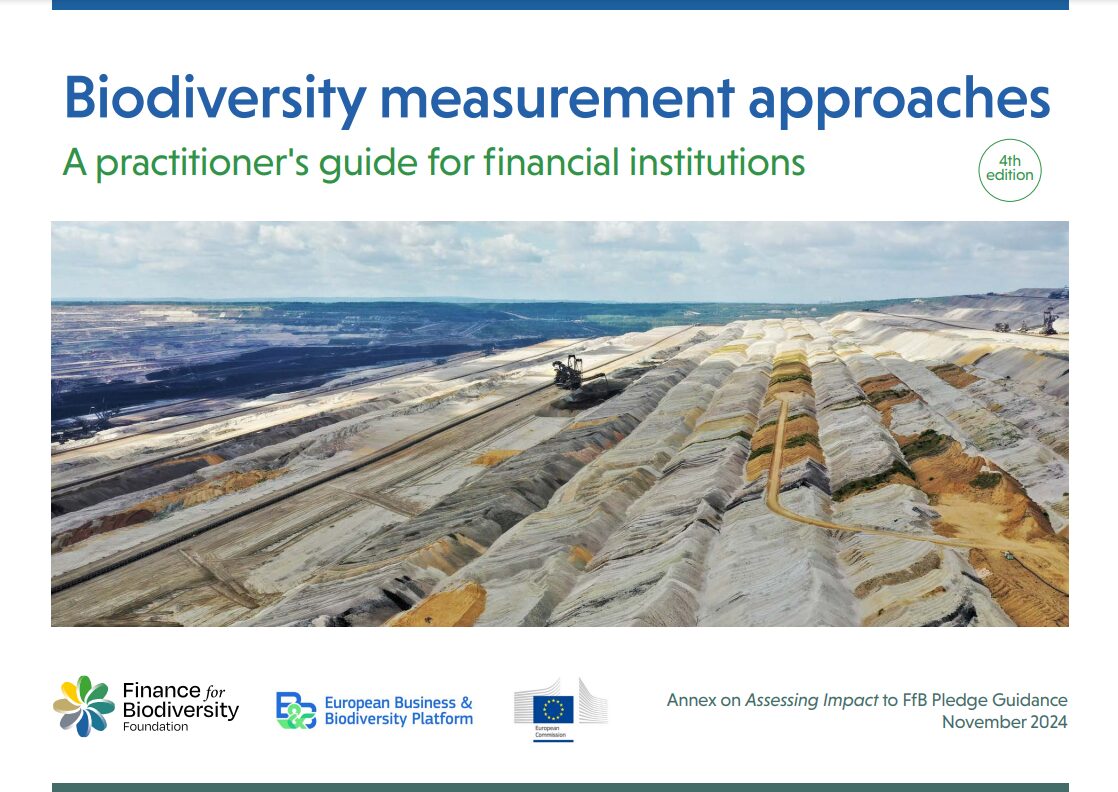Fourth Update of the ‘Biodiversity Measurement Approaches’ Guide
The fourth edition of ‘Biodiversity Measurement Approaches – A Practitioner’s Guide for Financial Institutions’ has been released today at COP16 in Cali, Colombia. Presented during an event on biodiversity measurement approaches at the Finance and Biodiversity Pavilion, with a panel of experts in the field, this comprehensive guide was developed by the Finance for Biodiversity (FfB) Foundation and the EU Business & Biodiversity Platform.
Expanding on the work laid by its previous editions, the Guide’s fourth edition offers information and assistance to financial institutions in understanding the existing approaches for measuring their interactions with biodiversity.
Measuring biodiversity impact is a crucial step for financial institutions
As biodiversity loss becomes an ever more urgent challenge, financial institutions are looking for ways to quantify the impacts and dependencies of their finance and investment activities on biodiversity. Therefore, assessing impact is one of the five commitments of the Finance for Biodiversity Pledge. This guide is a revised edition of the 2024 (February) Guide on Measurement Approaches and serves as an annex to the ‘Assessing Impact’ section of the FfB Pledge’s more generic Guidance to the Pledge document.

What’s new in this edition?
The following are the new elements of the fourth edition of the Guide:
– Four new tools included (making a total of twelve – see full list below)
– Updated information for all tools and new case studies per tool
– Updated sections on data challenges and measurement recommendations for financial institutions
– Criteria for assessing and describing the tools 100% aligned with the upcoming sister Update Report 5 from the EU Business and Biodiversity Platform (Workstream Methods)
Overview of twelve biodiversity measurement tools
Based on considerations within the F&B Community, this guide only includes biodiversity measurement approaches that:
- Are relevant to, and are currently explored or used by, the financial sector;
- Include the direct main drivers of biodiversity loss identified by IPBES (2019) or provide insight into potential nature-related risks;
- Are considered to be scientifically robust.
The following list includes the twelve tools assessed in this guide. The majority of these tools have multiple applications and can be used for different purposes, including supporting investor engagement programs, portfolio management strategies, and other investor decision-making processes.
- ENCORE (2024 version) – Exploring Natural Capital Opportunities, Risks and Exposure (Global Canopy, UNEP-FI and UNEP-WCMC)
- IBAT – Integrated Biodiversity Assessment Tool (BirdLife International, Conservation International, IUCN, UNEP-WCMC)
- BRF – Biodiversity Risk Filter (WWF)
- BIA-GBS – Biodiversity Impact Analytics – Global Biodiversity Score (CDC Biodiversité and Carbon4 Finance)
- GBS-FI – Global Biodiversity Score for Financial Institutions (CDC Biodiversité)
- CBF – Corporate Biodiversity Footprint (Iceberg Data Lab)
- BFFI – Biodiversity Footprint for Financial Institutions (CREM and PRé Sustainability, together with ASN Bank)
- GID – Global Impact Database (Impact Institute)
- MBFM – Biodiversity Footprint Metrics (MSCI)
- BIAT – Biodiversity Impact Assessment Tool (ISS ESG)
- NRP – Nature Risk Profile (UNEP-WCMC and S&P Global S1)
- GIST NBS – BIGER Footprint, SLAM, DIRO 360 (GIST Impact)
The Guide emphasises the suitability of each tool for specific organisational focus areas, business applications and asset categories, while outlining their respective strengths and limitations. Additionally, it provides detailed information on each tool’s data and resource requirements, along with insights into the scopes and pressures covered.
The Guide begins with a set of practical recommendations for FIs. This is followed by the twelve measurement approaches included within the guide and a description of the criteria used to assess them, which are aligned with those from the report series ‘Assessment of biodiversity measurement approaches’, developed by the Methods Workstream of the EU Business Biodiversity Platform.
Read the Biodiversity Measurement Approaches Guide here.